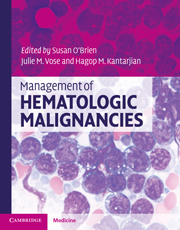Book contents
- Frontmatter
- Contents
- List of contributors
- 1 Molecular pathology of leukemia
- 2 Management of acute myeloid leukemia
- 3 Treatment of acute lymphoblastic leukemia (ALL) in adults
- 4 Chronic myeloid leukemia
- 5 Chronic lymphocytic leukemia/small lymphocytic lymphoma
- 6 Myelodysplastic syndromes (MDS)
- 7 Hairy cell leukemia
- 8 Acute promyelocytic leukemia: pathophysiology and clinical results update
- 9 Myeloproliferative neoplasms
- 10 Monoclonal gammopathy of undetermined significance, smoldering multiple myeloma, and multiple myeloma
- 11 Amyloidosis and other rare plasma cell dyscrasias
- 12 Waldenstrom's macroglobulinemia/lymphoplasmacytic lymphoma
- 13 WHO classification of lymphomas
- 14 Molecular pathology of lymphoma
- 15 International staging and response criteria for lymphomas
- 16 Treatment approach to diffuse large B-cell lymphomas
- 17 Mantle cell lymphoma
- 18 Follicular lymphomas
- 19 Hodgkin lymphoma: epidemiology, diagnosis, and treatment
- 20 Treatment approaches to MALT/marginal zone lymphoma
- 21 Peripheral T-cell lymphomas
- 22 Mycosis fungoides and Sézary syndrome
- 23 Central nervous system lymphoma
- 24 HIV-related lymphomas
- 25 Lymphoblastic lymphoma
- 26 Burkitt lymphoma
- Index
- References
25 - Lymphoblastic lymphoma
Published online by Cambridge University Press: 10 January 2011
- Frontmatter
- Contents
- List of contributors
- 1 Molecular pathology of leukemia
- 2 Management of acute myeloid leukemia
- 3 Treatment of acute lymphoblastic leukemia (ALL) in adults
- 4 Chronic myeloid leukemia
- 5 Chronic lymphocytic leukemia/small lymphocytic lymphoma
- 6 Myelodysplastic syndromes (MDS)
- 7 Hairy cell leukemia
- 8 Acute promyelocytic leukemia: pathophysiology and clinical results update
- 9 Myeloproliferative neoplasms
- 10 Monoclonal gammopathy of undetermined significance, smoldering multiple myeloma, and multiple myeloma
- 11 Amyloidosis and other rare plasma cell dyscrasias
- 12 Waldenstrom's macroglobulinemia/lymphoplasmacytic lymphoma
- 13 WHO classification of lymphomas
- 14 Molecular pathology of lymphoma
- 15 International staging and response criteria for lymphomas
- 16 Treatment approach to diffuse large B-cell lymphomas
- 17 Mantle cell lymphoma
- 18 Follicular lymphomas
- 19 Hodgkin lymphoma: epidemiology, diagnosis, and treatment
- 20 Treatment approaches to MALT/marginal zone lymphoma
- 21 Peripheral T-cell lymphomas
- 22 Mycosis fungoides and Sézary syndrome
- 23 Central nervous system lymphoma
- 24 HIV-related lymphomas
- 25 Lymphoblastic lymphoma
- 26 Burkitt lymphoma
- Index
- References
Summary
Introduction
Lymphoblastic lymphoma (LBL) is a rare disease which accounts for approximately 2% of all non-Hodgkin lymphomas (NHLs). Most commonly it is of T-cell immunophenotype with about 20% being B cell. LBL is morphologically and immunophenotypically identical to acute lymphoblastic leukemia (ALL). The World Health Organization (WHO) classification of lymphoid neoplasms unifies these entities as precursor T-cell and B-cell lymphoblastic leukemia/lymphoma. In the clinical literature, treatment approaches to LBL and ALL have been parallel but have developed separately. In view of the rarity of LBL and the variable (and arbitrary) clinical distinction between LBL and ALL, reported results have been variable and the optimal treatment approaches remain uncertain.
Clinical presentation
In adults, it is usually diagnosed in males (2:1 ratio), with a peak incidence in the second decade of life. T-cell lymphoblastic lymphoma (T-LBL) typically presents as symptomatic supradiaphragmatic adenopathy. Cough, shortness of breath, and B symptoms are common. A large anterior mediastinal mass can result in respiratory distress and accompanying pleural and pericardial effusions can lead to tracheal obstruction or cardiac tamponade. Bone marrow involvement at presentation is seen in approximately 50% of the patients. Central nervous system (CNS) involvement is variable ranging from 0% to 26% at presentation in different studies and is typically leptomeningeal rather than parenchymal. Hence cytologic evaluation of spinal fluid is recommended in all patients at the time of diagnosis. Primary intra-abdominal adenopathy at presentation is unusual.
- Type
- Chapter
- Information
- Management of Hematologic Malignancies , pp. 487 - 493Publisher: Cambridge University PressPrint publication year: 2010

